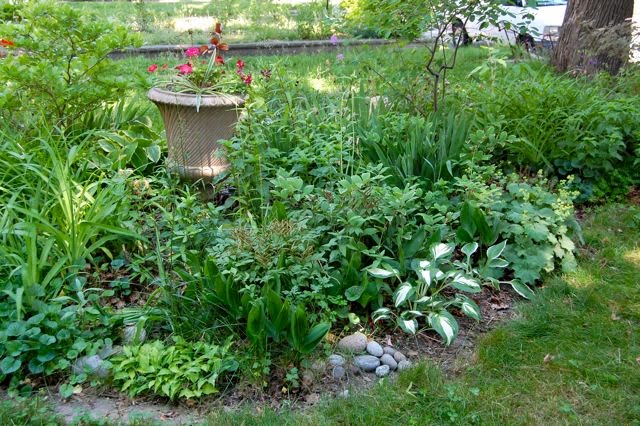This photo of my sad front garden (let’s simply call it the before picture) illustrates why I’m sooooo happy to be taking this Art and Management of Landscape Design course [ed. actually, I have the name wrong. It’s the Art and Management of Planting Design – even better!] at Ryerson University.
Instructor Michelle Reid outlined it in her course overview tonight: no matter how beautiful the garden design, it will fail over time unless you consider early in the game how the garden will be managed once installed.
In addition to sound design principles, Reid stresses the need to really understand the site conditions and the cultural requirements of the plants you select to go into the landscape – as well as how the garden will be maintained for the long term. This music to my ears told me that hers is just the course I’ve been looking for. It will help me take a giant step forward: to not only create a better garden, but create one that is sustainable.
More news as it comes in. Course number two at the Toronto Botanical Garden on Tuesday.





8 comments
Okay Helen! This is perfect for many of us struggling with our design and not knowing what is wrong or how to fix it. We do expect frequent updates with lots of details. 🙂
Frances
Sounds wonderful – how I wish I could join you? Can I second Frances' requests for updates?
Out of interest – how much of the course looks at plant choices? I'm interested with my OOTS hat on because I'm wondering whether planting is neglected in most landscape/design courses and whether that (and budget constraints) may help to explain the lack of variety in public planting.
However, it might only the UK where this shortfall lies and not in Canada – especially Toronto, which I read recently is set to be a world leader in rooftop gardening! Now that would make a good OOTS subject 😉
My teacher at George Brown said the same thing(that is good news). He said that most people are too ambitious and the garden ends up ruling their life, instead of them enjoying it. That is one reason I am trying to design a lot of green architecture and plant a large number of trees and shrubs, instead of a lot of herbaceous borders. (Boy, that takes will power!)
That does look like a great course! I'm such a beginner – last year was the first time I had ever even put a plant in the ground.
For an abject newbie, would there be any value in taking a really intro-level course (GBC offers one that looks to be at about my speed: http://tinyurl.com/y8vb8fs ), or would I be better off just mucking about on my own for a couple of years?
I'm so glad you're taking this course, and hope to read lots of updates! It's one of the main things (if not THE main thing) I really try and emphasize w/my clients…to realistically consider the level of maintenance required for their desired garden. So often people want the packed-in English Cottage garden, thinking they'll be able to maintain it with the occasional hour or two of puttering!
VP is right, most landscaper designers have a very limited knowledge of plants, using the same selection of material over and over again.
I wish they could find a middle ground and realize that gardening is not only the creation of a space that relates to the house, but is also a place where one can study plants, botany and, gardening folklore.
The best gardeners strive to create a well designed space as well as being good plantsmen.
What excellent advice. I have struggled for years as a horticulturist who had to maintain landscapes that were created by landscape architects who did not view the landscape's future appearance and maintenance needs. I look forward to hearing more about your classs 🙂
Great article you got here. I'd like to read more concerning that topic. Thnx for posting this data.
Joan Stepsen
Purely gadgets